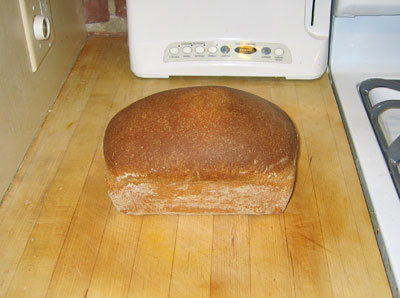Whole Grain Whole Wheat Bread – One Loaf
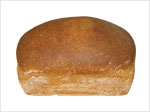 There’s nothing like fresh home made bread and it is not as difficult to make as you might think. When you make your own bread you can select the best, most wholesome ingredients. I like to use organic stone ground 100% whole grain whole wheat flour. Make sure to buy whole grain whole wheat flour because you will be assured that the whole grain will be included and nothing will be discarded in the milling process. Nowadays, when you buy “whole wheat” flour, the milling company will throw away the bran and the outer parts of the grain. Insist on 100% whole grain.
There’s nothing like fresh home made bread and it is not as difficult to make as you might think. When you make your own bread you can select the best, most wholesome ingredients. I like to use organic stone ground 100% whole grain whole wheat flour. Make sure to buy whole grain whole wheat flour because you will be assured that the whole grain will be included and nothing will be discarded in the milling process. Nowadays, when you buy “whole wheat” flour, the milling company will throw away the bran and the outer parts of the grain. Insist on 100% whole grain.
You can buy yeast in individual packets at your local supermarket but I find that it is expensive (about a buck and a half per packet – ouch!). I was able to buy a 2 lb bag of Red Star Active Dry Yeast for $3.89 from our local Costco store. Each packet is about 2 tsp of yeast so when you buy yeast in bulk you use 2 tsp when the recipe calls for 1 packet.
Ingredients: Makes 1 Loaf – 9 x 5 inch pan
- 4 1/2 – 5 cups organic stone ground 100% whole grain whole wheat flour
- 1 pack (or 2 tsp) active dry yeast
- 1 1/2 cups warm water (120°F)
- 1/2 cup whole milk
- 1/3 cup honey
- 1/3 cup vegetable oil
- 1 1/2 tsp salt
Heat up a pan of water in a small saucepan. Use tap water, filtered tap water or spring water. Do not use distilled water because the yeast requires some mineral content to grow. Pour heated water into a measuring cup and check temperature with yeast thermometer. When the temperature is at 120°F, add water to mixing bowl with the honey.
Mix the warm water until the honey dissolves and then lightly sprinkle the yeast over the top of the water. The yeast will activate best between 110°F – 120°F and the honey will kick start it by giving it a meal. By starting at 120°F, the water will cool down a few degrees while mixing it with the honey and will bring the temperature down into the ideal range. Let this set for about 10 minutes to allow the yeast to get foamy at the top. You want to make sure the yeast is alive, otherwise, if it doesn’t get foamy, the yeast is dead. This is called “proofing the yeast”.
While you are waiting for the yeast to kick start, grease a 9 x 5 inch loaf pan loaf pan with butter then flour it with some of the whole grain whole wheat flour. Insist on whole grain whole wheat. Regular whole wheat is not whole grain because the milling company throws away all the bran and outer parts of the grain. With whole grain whole wheat, nothing is thrown away and you get everything.
Next, add the milk and then stir it up with a wooden spoon and then add the flour a little at a time. Don’t add the oil or salt yet. They will be added after the next step. Start by adding about 2 1/2 cups of flour and then mix it into a thick batter. Stir in the flour and mix it together really good so all the lumps are gone. Then cover the bowl with a towel and let it rise for about 30 minutes until the dough is spongy and it has doubled in size.
When you let the dough rise into a spongy texture before adding the rest of the flour and before turning it out on a board for kneading, it is called the “sponge method”. One advantage is that you can get 3 rises before baking. The extra rising helps develop the yeast and also helps make the dough stretchy. This is the first rise. All the rising should be done at room temperature – not too cold and not too hot.
After the dough has risen it should be spongy. Stir it up to deflate it and then add the oil and salt. Stir it in and add a little more flour. If you add the oil and salt too soon, it will inhibit the growth of the yeast. Salt can kill the yeast so you add the oil and salt after the yeast has had a good chance to get growing and multiplying after the first rise.
Add some more flour and keep stirring. Keep adding flour until the dough gets stiff and starts to pull away from the bowl and then turn it out on a lightly floured board for kneading. Slowly and gently begin kneading the dough a little at a time at first. Only add a little bit of flour to the board at a time. Be careful not to add too much flour too fast. It should be pretty sticky at first and it will be sticking to your hands and on the bread board. Just lightly flour the board when it gets too sticky.
Knead the dough for a full 10 minutes while continuing to add flour a little at a time on the bread board. You’re not really measuring the flour. The rest will all be taken up a little at a time during the kneading so you will only add flour as necessary to achieve the desired dough consistency. You want the gluten to develop in the kneading process without adding too much flour. The goal is to knead the dough for anywhere between 10 and 30 minutes (or even more – there is no set time). If you add too much flour too fast, the bread will turn out crumbly like cake. Learning how to knead the dough takes patience and practice.
Thorough kneading will develop gluten and cause the dough to be smooth and elastic and allow the dough to rise properly. Insufficient kneading won’t make the dough stretchy enough to allow gas pockets to develop and you’ll wind up baking a brick instead of a loaf of bread. When the dough is stretchy and it no longer sticks to your hands or to the board after 2 or 3 kneads, then it is ready to rise for a second time.
Add about a teaspoon of vegetable oil into the bowl and then place the ball of dough into the bowl and turn it over a couple of times so it is coated all over with oil to keep it from sticking to the bowl. Cover it with a towel again and let it rise for about an hour until it has doubled in size again. This is the second rise.
After the dough has risen, punch it down to de-gas it and deflate the dough. Get all the gas out of it. Next, shape the dough into a log shape and place it into the floured loaf pan. It will help if you knead it a few times before shaping it. Pat it down real good in the loaf pan and allow to rise one more time until it has doubled in size again. This is the third rise. This can take anywhere from 30 minutes to an hour depending on the temperature, how well the yeast got started, how well the dough was kneaded and the quality of the flour.
Just before the dough has finished rising, preheat the oven to 350°F. Bake at 350° for about 45 minutes. Afterwards, pop the loaf out of the pan and set it aside and allow it to cool.
Start by heating the water up on the stove in a small saucepan. While it is heating up, measure out 1/3 cup of honey in a large mixing bowl.
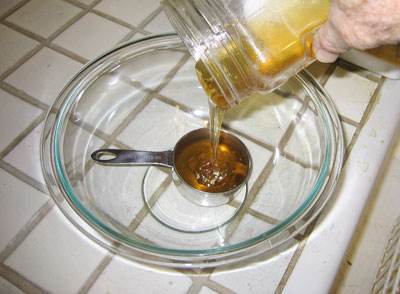
After a few minutes and long before the water begins to boil, add it to a measuring cup with a yeast thermometer. Measure out a cup and a half. When the temperature is around 120°F, but not more, then the temperature is just right.
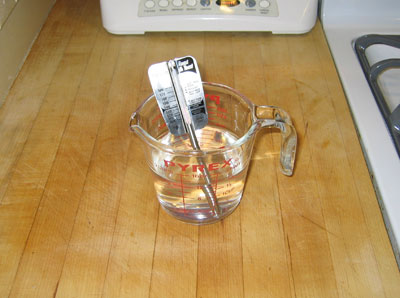
When the water temperature is 120°F, add it to the bowl with the honey. Stir until the honey is dissolved and then lightly sprinkle the yeast over the top of the water. Allow to set for 10 minutes so the yeast starts multiplying and growing. The yeast will activate between 110°F – 120°F. Some people prefer the water temperature to be at 115°F but I prefer the temperature to be at 120°F because by the time the honey is dissolved it will tend to cool it down a bit. The honey provides nourishment for the yeast and allows it to start growing rapidly. After 10 minutes the yeast should look foamy on the top of the water. This is called “proofing the yeast” because the foam is proof that the yeast is alive. While you are waiting, grease a loaf pan with a pat of butter and flour it with some whole grain whole wheat flour.
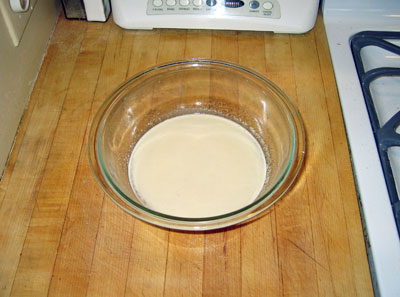
Add the milk and mix thoroughly with a wooden spoon.
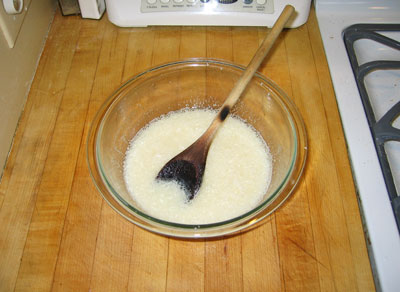
Add about 2 1/2 cups of flour and mix it into a batter. Don’t add the oil or salt yet.
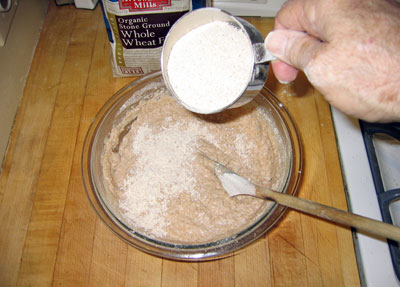
Keep stirring the flour until there are no more lumps. It is now ready for the first rise.
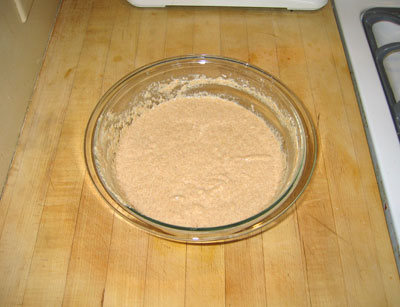
Cover with a towel and let stand for about 30 minutes. All the rising should be done at room temperature – not too cold and not too hot.
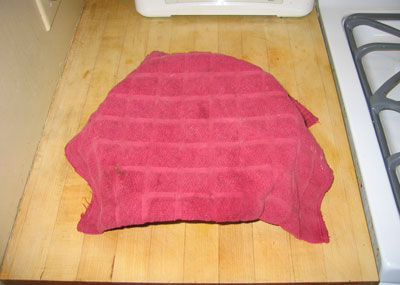
After rising, the dough should be about double in size and it should have a spongy texture. This is the “sponge method” of making bread. The dough will be spongy and the first rise gives the yeast a chance to really get growing.
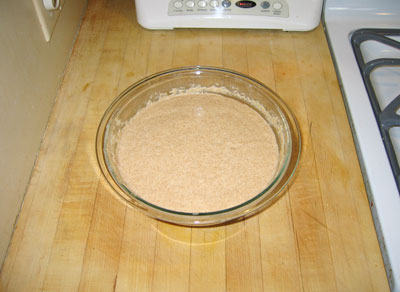
Stir it so the dough deflates and then add the oil and salt and stir everything to mix thoroughly.
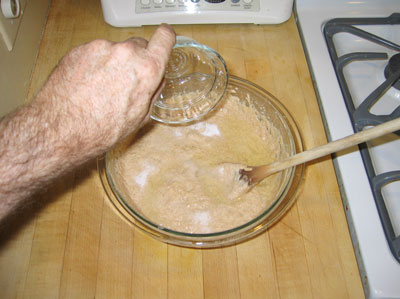
Add some more flour a little at a time and keep stirring. When it becomes difficult to stir and it starts to pull away from the sides of the bowl, then it is time to transfer it to a floured bread board and start kneading.
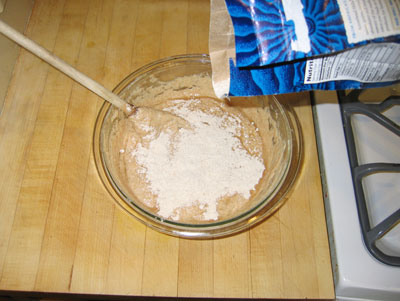
The trick is to know when the dough is ready for kneading. You want it to be sticky like the photo below.
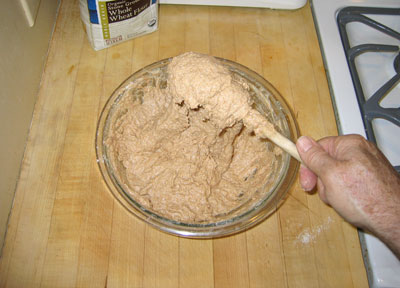
Turn the dough out onto a lightly floured bread board or counter. It should start out as a sticky mass. As you knead the dough it will take up more flour and become less sticky and should gradually become smooth and stretchy.
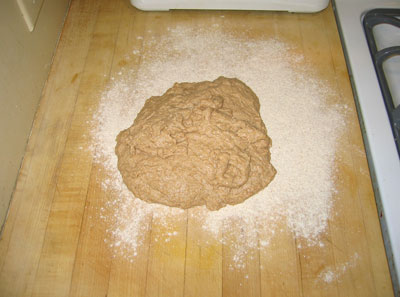
Gradually knead the dough very gently at first and slowly add a little bit of flour at a time to the board or counter. You want to give it a chance to develop gluten and not add too much flour or add it too fast. If you add too much flour or add it too fast, the bread may turn out crumbly like cake. Kneading takes practice and patience.
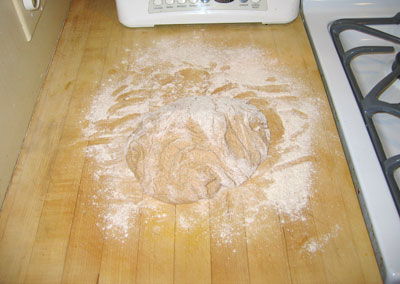
Continue to knead the dough, pushing it out across the surface while pressing down. Kneading can take between 10 to 20 minutes or even 30 minutes or longer. The important thing is to have the right balance of water and flour. You want the dough to be very stretchy and smooth after a thorough kneading.
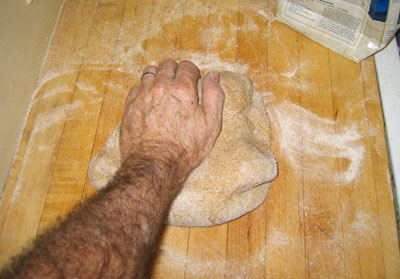
When the dough is smooth and stretchy and no longer sticks to your hands or to the counter after 2 or 3 kneads, it will be ready for a second rise. Form it up into a ball.
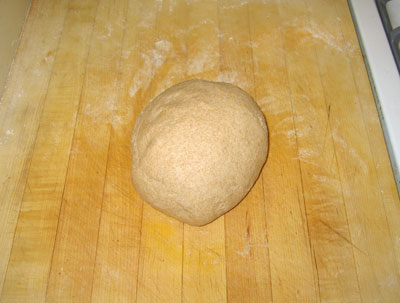
Add a little oil (about a teaspoon) to the bowl and then place the ball of dough into it. Turn it over a few times so it is completely coated with oil and won’t stick to the bowl.
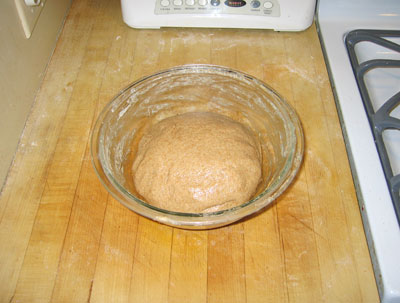
Cover with a towel and allow to rise for about an hour. This is the second rise.
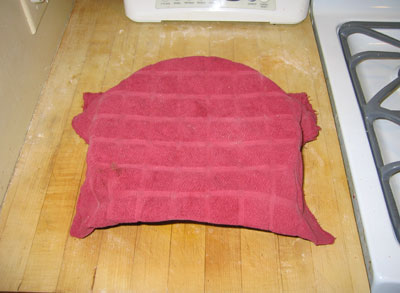
The dough should double in size after about an hour.
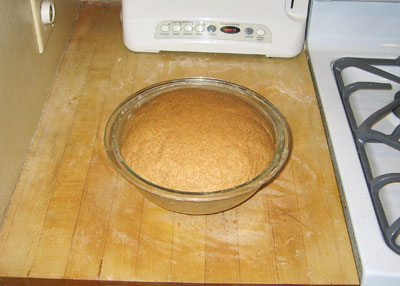
Punch it down to deflate the dough and get rid of all the gas.
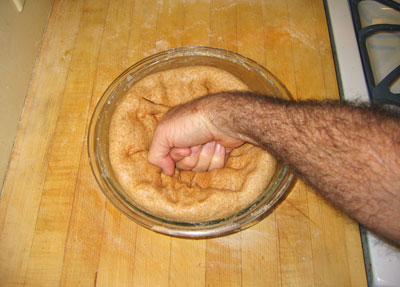
Turn it out onto the board and let it stand for a minute or so.
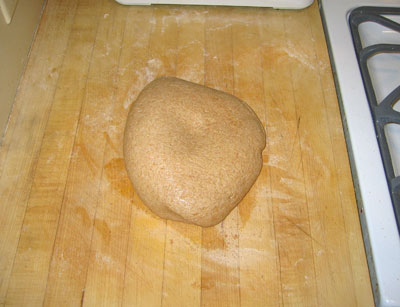
Knead the dough a few times to get rid of any seams or holes, then roll it out into a log shape, patting the ends back inwards. Keep rolling and patting the ends back until the dough is log-shaped and fits into a regular loaf pan
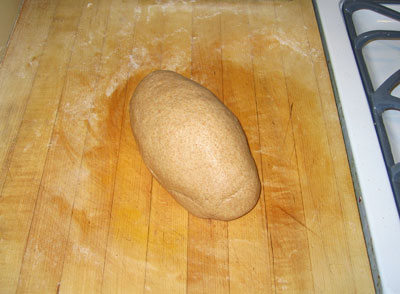
Place the prepared dough in a greased and floured 9 x 5 inch loaf pan. Pat it down real good in the pan.
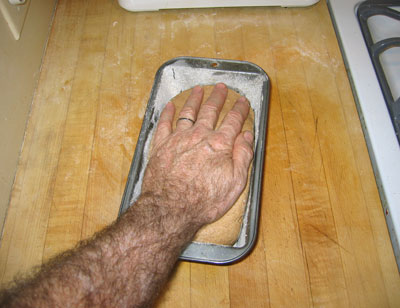
The dough is ready for the third and final rise. Set it aside and allow to rise until it is a little more than double the size. This can take anywhere from 30 minutes to an hour or more.
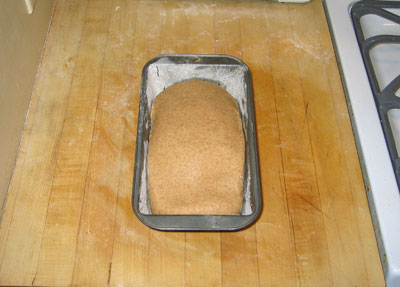
Allow the dough it to rise until it is about 2 to 2 1/2 times the original size. The amount of time will vary depending on the temperature, how well the yeast reproduced and how thoroughly the dough was kneaded. It should take about an hour to rise. Before the dough has finished rising, preheat the oven to 350°F.
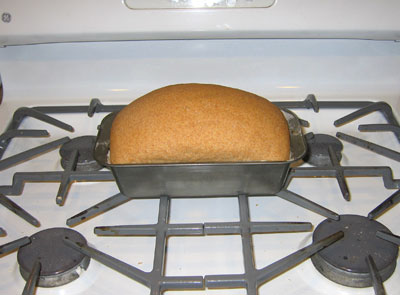
Bake in the oven at 350°F for 45 minutes or until golden brown.
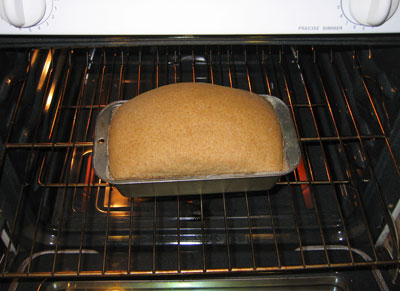
After baking, remove from oven and tip it over gently to remove the bread from the pan. Set it aside and allow it to cool for a little while.
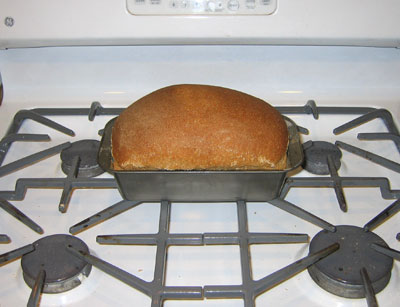
Here’s your finished loaf of bread. This is a very delicious recipe. You can’t find bread like this in a store and it’s easy to make. You can slice it with an electric knife or a bread knife to make nice, straight and uniform slices.
